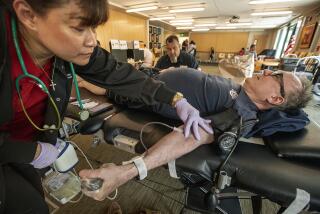Blood Banks Afflicted by Donor Shortage
- Share via
MONTCLAIR, N.J. — The tuna salad sandwiches were fresh, the cookies homemade and a “Blood Drive Today” sign out front beckoned motorists.
But inside Montclair’s Red Cross office on last month’s designated day for donations, rows of beds stood empty and workers passed the time chatting about weekend plans.
Across the country, America’s blood harvest is drying up.
Blame it on the misplaced fear of AIDS, the aging of patriotic Americans who began donating in World War II or the increasing frequency of body-piercing, tattoos and other short-term factors that temporarily prevent willing donors from giving blood.
Blood donations have been sinking steadily over the last dozen years, and those in the business are struggling to attract new donors.
“Montclair is no different than any other community. This is happening all over,” said Barbara McDonald, a New Jersey Blood Center nurse.
In 1982, before fears about tainted blood supplies were widespread, this Red Cross chapter collected 1,816 pints of blood in its 12 monthly drives. By 1989, donations had dipped to 1,447 pints. Last year, a mere 831 pints of blood were collected.
“You can’t help but think there is some correlation with when people started learning about AIDS,” McDonald said. “And doing good deeds is out of favor.”
(Although AIDS can be transmitted by receiving a tainted transfusion, it cannot be transmitted by making a blood donation.)
While 8 million Americans donate 14 million pints of blood every year, they represent less than 5% of those healthy enough to give.
Ed Kaplan, 62, started donating when he was in the Army, but he hasn’t been able to get his 35-year-old son to give.
“He doesn’t like needles,” Kaplan said, munching on goodies after giving his 80th pint. “If I could only get him here once, he’d see it’s not painful.”
Apart from cold feet, other physical conditions--and increasingly stringent safety requirements--keep people from donating, at least temporarily. People with new tattoos or pierced ears, noses and other body parts, or who have spent more than 72 hours in jail must wait a year before giving. The wait is also a year for people who have traveled to areas with malaria, and three years for immigrants who arrive from those areas.
Donors also must wait if they’ve had surgery, dental work or any kind of immunization, suffered from syphilis or gonorrhea, or been exposed to hepatitis, measles, mumps or chicken pox.
Blood is perishable, good for only 42 days, so hospitals need a constant supply. Critical shortages usually occur from mid-July through Labor Day, and again in late December and early January.
Type O is especially valued. O-positive blood, found in 39% of Americans, can be transfused into anyone with positive blood types, some 86% of the population. O-negative blood, found in only 6% of Americans, can be used by any patient, negative or positive.
“We have seen a decline of 2-3% [a year] nationwide for a number of years,” said Eric Slayton, director of strategic planning for the American Assn. of Blood Banks, based in Bethesda, Md.
Some tactics that have helped pull in new donors will be discussed at the organization’s annual meeting, beginning Friday in Orlando, Fla. Among them:
* On Valentine’s Day, the Topeka, Kan., blood bank tied its drive to NBC-TV’s popular “Friends” in a promotion called “Friends--Saving Lives Together.” The blood bank counted 297 donors, more than twice the number expected, with one-third younger than 25.
* In a direct appeal to 100 people with O-negative blood, the St. Louis Red Cross reminded them that actors in NBC’s “ER” and real doctors in real emergency rooms call for O-negative blood every day. The appeal persuaded 32 people to donate.
* Corporate layoffs in Farmington, Conn., were cutting into company blood drives. The Red Cross countered by grouping small businesses in joint drives and encouraging donors to give more often.
In 1982, Larry Frederick, then an Oakland, Calif., police officer, needed 110 pints of blood after being injured by a hit-and-run driver. Unconscious for a week, he received 54 pints the first day alone.
This summer, he and his 13-year-old son, Aaron, bicycled across the country, from San Francisco to Washington, stopping at 187 blood banks. The blood bank association credits him with motivating more than 50,000 people to donate.
More to Read
Sign up for Essential California
The most important California stories and recommendations in your inbox every morning.
You may occasionally receive promotional content from the Los Angeles Times.













